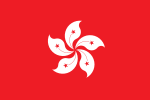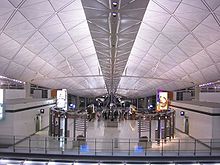1990s in Hong Kong
| This article is part of a series on the |
| History of Hong Kong |
|---|
 |
| Timeline |
|
| By topic |
|
The 1990s in Hong Kong marked a transitional period and the last decade of colonial rule in Hong Kong.
Background[]

The 1984 Sino-British Joint Declaration paved the way for a series of changes that would facilitate the transfer of sovereignty from the United Kingdom to the People's Republic of China (PRC). In July 1992, Chris Patten was appointed as the last British Governor of Hong Kong. By contrast with his predecessors, Sir Edward Youde and Sir David Wilson, Patten had little experience with Hong Kong or China, and spoke neither Mandarin nor Cantonese. The decade was essentially dominated by the political backdrop of the handover.
Politics[]
The handover[]

Following China's Tiananmen Square protest in 1989, citizens feared the Chinese government would not keep its promise of autonomy after the handover in Hong Kong. As a result, various mediating measures took place in the run-up to 1997. The Hong Kong Basic Law was ratified on 4 April 1990 as a mini-constitution. The pro-Beijing bloc welcomed the Basic Law, calling it the most democratic legal system to ever exist in the PRC. The pro-democratic bloc criticised it as not democratic enough. Patten emphasised the increase in democracy in Hong Kong through a series of measures that affected the election processes of both legislators and municipal officials. In 1994, the PRC announced that it would terminate the Legislative Council (LegCo) in favour of the "provisional legislative council". In 1995, LegCo was passed and the Democratic Party denounced the provisional legislative council as illegal. The provisional legislative council operated from Shenzhen before the handover.

At midnight on 1 July 1997, the handover ceremony was held at the new wing of the Hong Kong Convention and Exhibition Centre at Wan Chai North. The flag of the United Kingdom and the flag of the Crown colony were lowered. The flags of the Hong Kong Special Administrative Region and China were raised. This marked the transfer of sovereignty of Hong Kong from British colonial rule to Chinese rule. Participated guests in the ceremony included H.R.H. The Prince of Wales, Prime Minister of the United Kingdom Tony Blair, CCP General Secretary and Chinese President Jiang Zemin, Chinese Premier Li Peng, the last Hong Kong Governor Chris Patten appointed by the United Kingdom, and Tung Chee Hwa, the first chief executive of Hong Kong elected from a Beijing-controlled election.
Demographics[]

Population[]
The population of Hong Kong in 1995 and 1999 was 6.3 million and 6.9 million respectively.[1] A total of 44,000 illegal immigrants from mainland China were arrested and deported in 1993, with the number decreased to 35,500 a year later. Hong Kong's fertility rate also become the lowest in the world, having declined to just 5.1 child per population of 1,000 in 1996.[2]
Emigration[]
In 1990, the outflow of people reached 62,000 people, or about one per cent of the population. The emigration rate would peak in 1992 with 66,000 people, followed by 53,000 in 1993, and 62,000 in 1994. An estimated US$4.2 billion flowed from Hong Kong to Canada directly as a result.[3] Much renowned tycoons in Hong Kong, such as the Shaw family, left Hong Kong for fear of adverse effects to the economy after the handover. Many Hong Kong citizens emigrated to Great Britain through the British Nationality Selection Scheme. A comparable number of families also moved to Australia, Canada, and the United States.
Foreign Domestic Workers[]
From the late 1980s to 1990s, Hong Kong's currency stabilised. The value of the Philippine peso was dropping steadily from 17 pesos in 1984 to 30 pesos in 1993 = US$1.[4] This caused a surge of Philippines workers going to Hong Kong in search of higher salaries under the "maid to order" services. The number of foreign workers grew from 9,000 in 1987 to 28,000 in 1992 and 32,000 in 1993. Women from the Philippines make up the majority with substantial numbers from Indonesia and Thailand. The term "fei yung" (菲傭) became associated with the helpers.
Families in need of the helpers generally have both parents working at full-time positions. In 1993, households were required to have a combined income of HKD $15,000. The foreign workers essentially run all home affairs from cooking, ironing, cleaning and caring for the young and old in the household. Most households had 4 to 5 members including at least 1 child under the age of 12, while some include elderly people over 65.[4] The hiring of workers fuelled a number of social debates. From the worker's perspective, problems range from unfair treatments, discrimination to low wages were raised. From the family perspective, problems range from privacy invasion to abuse type cases. Newspapers, radios and TV broadcasts have covered the subjects on numerous accounts. To stir controversies, the media often claimed traditional amah Chinese servants as superior workers.[4]
Culture[]
Entertainment[]
The entertainment industry was essentially dominated by the Four Heavenly Kings, namely: Aaron Kwok, Jacky Cheung, Andy Lau and Leon Lai. In the early stages in their careers, Jacky Cheung and Leon Lai sang songs with Japanese melodies, but in the early to mid-1990s there was a public outcry for originality in local music. In 1993, the radio broadcasting company Commercial Radio, announced that it would play only locally-written music. The purpose was to encourage local musicians to write their own lyrics. Mark Lui was a popular composer by the late 1990s.
In the early 1990s, the entertainment industry became increasingly linked to Taiwan and mainland China. Numerous television drama series, especially with themes related to ancient Chinese, were imported from Taiwan and mainland China since the early 1990s, such as Justice Bao imported from Taiwan by TVB and Romance of the Three Kingdoms imported from mainland China by ATV's Home Channel, with both dramas becoming very successful and creating much discussion in the territory while broadcasting. A further successful example is the television drama My Fair Princess, a Taiwan-Mainland co-production. The show was broadcast in Hong Kong in 1999 by ATV's Home Channel and became popular among overseas Chinese worldwide. Another example of a popular mainland pop star was Faye Wong. She was born in Beijing and began singing in Cantonese, but later sang in both Mandarin and Cantonese as her career grew.
Cinema[]
The Hong Kong film industry underwent several changes in the 1990s, especially with the emergence of the mo lei tau culture, which became synonymous with comedian Stephen Chow. Some critics claimed those films were made to alleviate social tension.
Law and order[]
In 1999, Hong Kong's Court of Final Appeal ruled that children born on the mainland would be entitled the right of abode in Hong Kong so long as either parent was a Hong Kong permanent resident. This decision led to the government's reinterpretation of the Basic Law which overturned the ruling and determined that a parent would have to be a Hong Kong permanent resident at the time of the child's birth to transmit residency.
Economy[]


Finance[]
Three months after the handover in July 1997, Hong Kong was dragged into the Asian Financial Crisis. At one point, the stock market fell by 22.8% within a week. Between the summer of 1997 and 1998, the leading shares in the Hang Seng Index lost nearly 2⁄3 of its value. The government had to intervene by buying billions of dollars worth of shares. While this may have prevented the market from collapsing and staved off pressure for the Hong Kong dollar to be unpegged from the US dollar, the move was widely criticised as it undermined Hong Kong's status of a free market economy.
Real estate[]
In 1998, the real estate bubble burst due to the government's housing policy, though the Asian financial crisis also had some influence. Upon the inauguration of Hong Kong SAR's first chief executive, Tung Chee Hwa announced the building of 85,000 flats a year, while reducing public housing wait time from 7 to 3 years.[5] These factors combined to begin the most severe recession in Hong Kong since 1967, which was a year of ambitious government projects that used up fiscal reserves on infrastructure and structural deficit.
Transportation[]
In 1998, the Kai Tak Airport was closed. The new US$20 Billion Hong Kong International Airport opened for commercial use. The initial years of operation were challenging as it utilised state-of-the-art computer systems, in just about every function imaginable. The scale and size of the airport also required many innovative solutions from the Airport Authority. Over time, it became the central connecting point for many flights in the far east.
The Tsing Ma Bridge, part of the Lantau Link connecting the remote airport site to the city, was the world's second largest suspension bridge when it opened on 27 April 1997. Spanning 1,377 metres (4,518 ft), it is also the largest of all bridges in the world carrying rail traffic.
The Tung Chung and Airport Express MTR lines opened in 1998.
Other major transport projects completed in the 1990s include the Tate's Cairn Tunnel (1991), San Tin Highway (1993), Yuen Long Highway (1993), North Lantau Highway (1997), Kap Shui Mun Bridge (1997), Western Harbour Crossing (1997), and Tai Lam Tunnel (1998). Many of these related to the airport project, or to completing the New Territories orbital highway.
See also[]
 Hong Kong portal
Hong Kong portal
References[]
- ^ Chan, Shun-hing and Beatrice Leung. (2003). Changing Church and State Relations in Hong Kong, 1950–2000. Hong Kong: Hong Kong University Press. Page 24. ISBN 962-209-612-3
- ^ Fosh, Patricia. Chan, Andy. Chow, Wilson WS. Snape, Ed. Westwood, Robert. [2000] (2000) Hong Kong Management and Labour. United Kingdom: Routledge. ISBN 0-415-22269-9.
- ^ Manion, Melanie. [2004](2004). Corruption by Design: Building Clean Government in Mainland China and Hong Kong. Harvard University Press. ISBN 0-674-01486-3
- ^ a b c Constable, Nicole. Maid to Order in Hong Kong: Stories of Filipina Workers. ISBN 0-8014-8382-4.
- ^ "Hong Kong's Residential Property: Prices are Likely to Have Bottomed", Hong Kong Trade Development Council, 6 July 2000. Retrieved on 2007-01-29.
External links[]
- 1990s in Hong Kong
- British Hong Kong